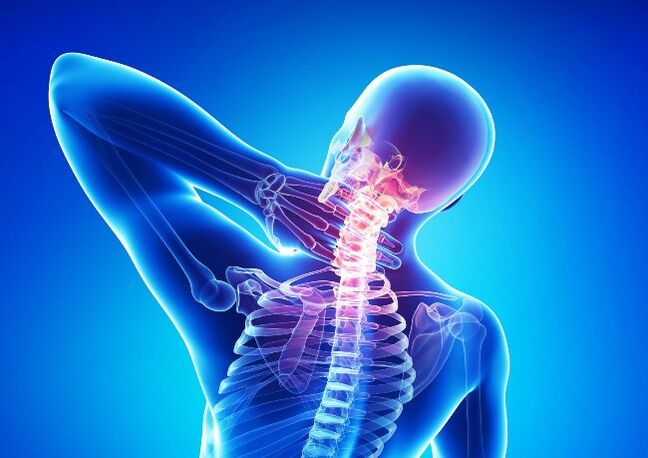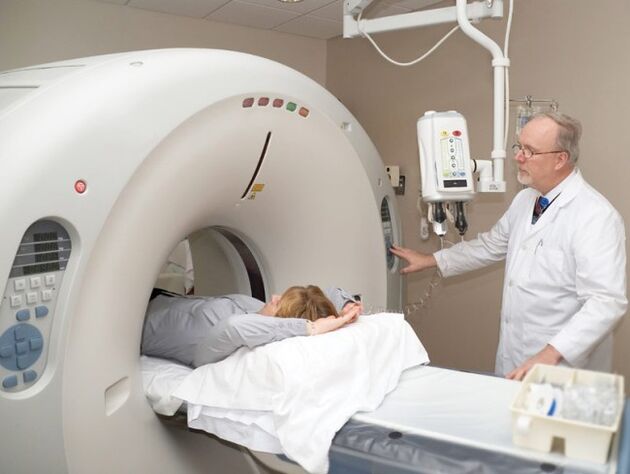Neck pain is a common symptom that everyone experiences at least once in their life. It can occur against the background of disease of the internal organs, stretching of muscles and ligaments, or hypothermia. If you have a sore neck, you should see a doctor. Only after examination and other diagnostic measures can the cause of the disease be determined and the right treatment chosen.

Neck pain can occur for various reasons. If you have a sore neck, you should see a doctor
Why do adults have neck pain?
Pain in the neck is divided into 2 types:
- sirvical - spasm occurs in one place, characterized by gradual course and varying degrees of intensity;
- Cervical - manifests itself with sudden head movements or unexpected pain with prolonged stay in one position.
Doctors determine the following causes of neck pain:
- Cervical osteochondrosis. The disease develops with a sedentary lifestyle and poor nutrition. Patients complain of neck and back pain, tinnitus and dizziness, difficulty turning the neck, the movements are accompanied by a crisis.
- Herniated discs. With such a pathology, the left side of the neck hurts, the disc comes out and causes pain in the lower back. The hernia can be treated with vacuum treatment and acupressure.
- Crick. After intense physical exertion, a person may feel a sharp pain in the neck. The affected area swells, it is impossible to turn the head, the risk of fainting increases. To alleviate the condition, the patient is given an anesthetic, a hot or cold compress, and a stretch massage.
- Cervical spondylosis. A dangerous disease that causes disability. It is often diagnosed in athletes or the elderly with trauma. There is constant pain in the neck and back of the head, and discomfort when turning the head. It is necessary to take medication to restore the ability to work to relieve inflammation and pain, to conduct physiotherapy in combination with physiotherapy exercises.
- Cervical myelopathy. It develops after narrowing of the spinal canal. The person feels weakness and pain in the neck. Speech slows down and coordination is impaired. The cause of the pathology may be a car accident or a fall from a height. The patient is advised to undergo physiotherapy, wear a soft collar and do strengthening exercises.
- Whiplash injury. Occurs after a fall, accident or battle. Accompanied by severe pain in any part of the neck. With a whiplash injury, the ligaments are damaged, causing the cervical lordosis to disappear and the head to come out. The treatment can last from 1 to 6 months.
- Cervical spine injury. A person sees constant neck pain and hematomas. In this case, you need to wear a special collar for 3 to 6 months.
- Infectious diseases. Skin infections cause severe pain and inflammation. With measles or sore throat, the lymph nodes in the neck expand and hurt.
- Diseases of the internal organs. If the pain syndrome occurs in the right hypochondrium and the neck hurts on the right side, the cause may be cholecystitis. If the neck hurts and whiskey is given in the morning, it is a sign of hypertension. Pain in the neck and arms with angina pectoris and myocardial infarction. Neck cramps and anterior pain can signal esophageal and thyroid disease. Nerve damage is observed during poisoning with toxic substances. Blood pressure spikes are possible with severe pain in the cervical spine. If the right neck hurts and it is impossible to move it, these are signs of meningitis. With laryngitis and pharyngitis, the pain can be localized to the right or left.

Often the neck hurts when lying down due to an uncomfortable position of the body or a hard pillow.
Often stress and psycho-emotional stress can cause discomfort in the neck and back. Pain and tingling sensations in the neck and shoulders will require an injection or anesthetic.
If the neck hurts under the jaw, this fracture may indicate osteomyelitis of the jaws or dysfunction of the temporomandibular joint. The patient with a broken lower jaw feels a strong pain syndrome, the soft facial tissues swell, it becomes painful or impossible to chew. Osteomyelitis is an infectious and inflammatory process, accompanied by fever, headache and chills.
Causes of a child's neck pain
Neck pain in a child can occur for the following reasons:
- Muscle overload while playing sports.
- Pain after a fall or car accident.
- An uncomfortable situation while sleeping or sitting at the computer.
- Meningitis: accompanied by increased irritability, headache, fever, photosensitivity, loss of appetite, nausea and vomiting. If left untreated, the disease can cause serious complications and death.
- Lyme disease. The pathology is often spread by tick bites, so it is necessary to check for signs of a bite on the neck when outdoors.
Pain medications are prescribed to treat neck pain and inflammation in children. Pulling a warm pillow around your neck for 20 minutes will help reduce muscle spasms. Also, the child should sleep with a towel or pillow collar around his neck to prevent his head from moving too often.
Diagnostics

To determine why the neck muscles are sore, the doctor examines them by palpation, after which additional examination methods are used:
- radiography;
- myelography;
- neurological examination of reflexes and sensitivity;
- computed tomography of the spine;
- MRI;
- nuclear magnetic resonance.
If you suspect osteomyelitis of the jaw, you should consult an otolaryngologist and dentist. In addition to the x-ray, the patient must undergo a blood test to determine the source of infection.
Drug treatment
When the neck is very painful with osteochondrosis, the doctor prescribes a complex therapy, including a special diet, a number of exercises, medications and preventive measures. The following groups of drugs are used to relieve pain and treat the disease:
- Anti-inflammatory drugs.
- Antispasmodics.
- Antioxidant drugs: ascorbic acid, vitamins E and N.
- Means that improve blood circulation.
- Preparations for the prevention of degenerative changes in cartilage tissue.
Medications can be used in various forms. Acute complications will require nerve blockade. There are several types of obstruction: intraosseous, paravertebral, facet, and epidural. All of them help to eliminate muscle-tonic syndrome.
It is useful to perform physiotherapy procedures with medication. They relieve pain and increase the therapeutic effect of drugs. The most effective procedures are magnetotherapy, laser therapy and treatment with low-frequency currents. Kinesiotherapy and physiotherapy exercises are prescribed to correct posture and strengthen the garden apparatus. If you exercise regularly, metabolic processes will be normalized, the position of the vertebrae and discs will be restored, and the load will be evenly distributed in the musculoskeletal system.

The principle of the diet for osteochondrosis is to add to the diet foods high in polyunsaturated fatty acids and antioxidants to improve metabolic processes. Meals should be in portions, up to 6 times a day.
It is recommended to include the following products in the menu:
- lean meat and fish;
- fresh vegetables and fruits;
- milk and fermented milk products;
- cereals;
- walnuts;
- seed;
- mushrooms;
- olive oil.
It is recommended to steam, boil or burn the dishes. You should also limit the use of flour products, spices, smoked meats, canned food, saturated meat broths, confectionery and fruits with high sugar content.
It is important!Strong black tea should be replaced with herbal decoctions, sugar-free fruit drinks and dried fruit compotes. Abstain from alcohol and carbonated beverages.
Chronic pain often irritates the patient, so the doctor prescribes sedatives and antidepressants. If the neck on the left side hurts, you can relieve the symptom with a warm pillow or a scarf around your neck.
Decongestants and anti-inflammatory drugs are used for cervical myelopathy. If the nerve endings are constricted, injections of steroid hormones will be required. When an infectious agent is found in the body, antibiotics are included in the course of treatment.
Note!In ischemic cervical myelopathy, the use of neuroprotectants and vasodilators is effective.
If a patient is diagnosed with cervical spondylosis, he is prescribed anti-inflammatory drugs and chondroprotectors. Analgesics are used with severe pain, muscle relaxants with severe muscle spasms. Manual therapy and gentle massage are also indicated. With an acute pain syndrome, blockade of the affected areas is recommended. It is useful to perform special complexes of physiotherapeutic procedures with drugs - electrophoresis with novocaine, ultrasound treatment and physiotherapy exercises.
Complications
If the neck hurts due to osteochondrosis, the wrong treatment or lack of it can lead to serious complications:
- intervertebral hernia;
- kyphosis;
- protrusion of the intervertebral disc;
- radiculitis;
- salt deposits in the spine;
- spinal cord injury;
- circulatory disorders;
- amiotrophy;
- paralysis of the lower extremities.
Prophylaxis

A number of rules should be followed to prevent neck pain:
- Avoid hypothermia.
- Quit smoking.
- Proper weight.
- Do physiotherapy exercises every day.
- Take a contrast shower.
- Visit the pool.
- Do not lift weights.
- Follow your posture.
- Warm your neck in the cold season.
- If you are in a static position for a long time, take a break every 50 minutes and restore blood circulation with warming.
- Choose an orthopedic mattress and pillows for sleeping.
- Wear comfortable shoes to reduce back stress.
- Walking barefoot on uneven surfaces in the spring to strengthen the muscles of the foot and relieve tension in the musculoskeletal system.
- Follow a proper diet.
- Take massage courses.
- Learn how to relax with increasing anxiety and emotion.



































